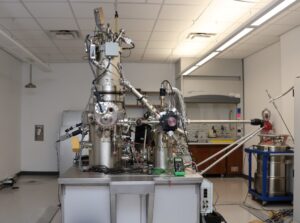Lesson 1.1 – The Structure of an Atom
An atom consists of two main regions:
1️⃣ The Nucleus (Core of the Atom)
- Located at the center of the atom
- Contains protons and neutrons (collectively called nucleons)
- Accounts for almost all the mass of the atom
- Held together by the strong nuclear force
2️⃣ The Electron Cloud (Region Surrounding the Nucleus)
- Contains negatively charged electrons
- Electrons move in specific energy levels (orbitals)
- The movement of electrons defines the size and shape of the atom
Atoms are composed of three main subatomic particles:
| Particle | Charge | Mass (amu) | Location | Function |
|---|---|---|---|---|
| Proton (p⁺) | +1 | ≈ 1 amu | Inside nucleus | Determines atomic number, defines element |
| Neutron (n⁰) | 0 (neutral) | ≈ 1 amu | Inside nucleus | Adds mass and provides nuclear stability |
| Electron (e⁻) | -1 | ≈ 1/1836 amu (negligible) | Outside nucleus (orbitals) | Involved in bonding & chemical reactions |
How Can We Observe Atoms? (Real-World Application: Scanning Tunneling Microscopes – STM)
Since atoms are too small to be seen with traditional microscopes, scientists use Scanning Tunneling Microscopes (STM) to visualize atoms.

🛠️ How Does an STM Work?
1️⃣ A sharp metal tip is placed extremely close to the surface of a material.
2️⃣ A tiny electric current flows between the tip and the atoms.
3️⃣ As the tip moves, variations in current create a map of the atomic surface.
4️⃣ This allows scientists to see individual atoms and their arrangements.
🌍 Why is STM Important?
✅ Helps scientists visualize atomic structures.
✅ Used in nanotechnology and materials science.
✅ Led to discoveries in quantum mechanics and atomic manipulation.
